Ionic Liquid Transdermal Patches of Two Active Ingredients Based on Semi-Ionic Hydrogen Bonding for Rheumatoid Arthritis Treatment
Abstract
1. Introduction
2. Materials and Methods
2.1. Materials and Animals
2.2. Synthesis of ILs
2.3. Preparation of Transdermal Patches
2.4. Drug Release
2.5. Optimization of Drug and Excipient Content
2.6. Fourier Transform Infrared Spectroscopy (FTIR)
2.7. Nuclear Magnetic Resonance Spectroscopy (1H NMR)
2.8. Raman Spectroscopy
2.9. X-ray Photoelectron Spectroscopy (XPS)
2.10. Molecular Docking
2.11. Target Network Pharmacology Analysis
2.12. Pharmacokinetics Study
2.13. Complete Freund Adjuvant–Induced Rheumatoid Arthritis
2.14. Western Blotting
2.15. Balance Beam Test and Imprinting Experiments
2.16. Skin Irritation and Barrier Function Study
2.17. Statistical Analysis
3. Results and Discussion
3.1. Effects of Counterions
3.2. Effects of PSA
3.3. Influence of Chemical Penetration Enhancers
3.4. Content Optimization of Drugs and Excipients
3.5. Characterization of the Action Mechanism
3.6. Molecular Docking
3.7. Target Network Pharmacology Analysis
3.8. In Vivo Therapeutic Effect and Bone Assessment
3.9. Western Blotting
3.10. The Beam Balance Test and Imprinting Experiments
3.11. The Skin Irritation and Barrier Function Experiment
4. Conclusions
Supplementary Materials
Author Contributions
Funding
Institutional Review Board Statement
Data Availability Statement
Acknowledgments
Conflicts of Interest
References
- Lei, Q.; Lei, Q.; Yang, J.; Li, L.; Zhao, N.; Lu, C.; Lu, A.; Lu, A.; Lu, A.; He, X. Lipid metabolism and rheumatoid arthritis. Front. Immunol. 2023, 14, 1190607. [Google Scholar] [CrossRef] [PubMed]
- Lin, Y.; Chen, Y.; Deng, R.; Qin, H.; Li, N.; Qin, Y.; Chen, H.; Wei, Y.; Wang, Z.; Sun, Q.; et al. Delivery of neutrophil membrane encapsulated non-steroidal anti-inflammatory drugs by degradable biopolymer microneedle patch for rheumatoid arthritis therapy. Nano Today 2023, 49, 101791. [Google Scholar] [CrossRef]
- Han, Y.; Huang, S. Nanomedicine is more than a supporting role in rheumatoid arthritis therapy. J. Control. Release 2023, 356, 142–161. [Google Scholar] [CrossRef] [PubMed]
- Liu, Y.; Cao, F.; Sun, B.; Bellanti, J.A.; Zheng, S. Magnetic nanoparticles: A new diagnostic and treatment platform for rheumatoid arthritis. J. Leukoc. Biol. 2021, 109, 415–424. [Google Scholar] [CrossRef] [PubMed]
- Zhao, J.; Jiang, P.; Guo, S.; Schrodi, S.J.; He, D. Apoptosis, Autophagy, NETosis, Necroptosis, and Pyroptosis Mediated Programmed Cell Death as Targets for Innovative Therapy in Rheumatoid Arthritis. Front. Immunol. 2021, 12, 809806. [Google Scholar] [CrossRef] [PubMed]
- Zhang, W.; Chen, Y.; Liu, Q.; Zhou, M.; Wang, K.; Wang, Y.; Nie, J.; Gui, S.; Peng, D.; He, Z.; et al. Emerging nanotherapeutics alleviating rheumatoid arthritis by readjusting the seeds and soils. J. Control. Release 2022, 345, 851–879. [Google Scholar] [CrossRef] [PubMed]
- Allen, A.; Carville, S.; McKenna, F. Diagnosis and management of rheumatoid arthritis in adults: Summary of updated NICE guidance. BMJ 2018, 362, k3015. [Google Scholar] [CrossRef] [PubMed]
- Thakur, S.; Riyaz, B.; Patil, A.; Kaur, A.; Kapoor, B.; Mishra, V. Novel drug delivery systems for NSAIDs in management of rheumatoid arthritis: An overview. Biomed. Pharmacother. 2018, 106, 1011–1023. [Google Scholar] [CrossRef]
- Abbasi, M.; Mousavi, M.J.; Jamalzehi, S.; Alimohammadi, R.; Bezvan, M.H.; Mohammadi, H.; Aslani, S. Strategies toward rheumatoid arthritis therapy; the old and the new. J. Cell. Physiol. 2019, 234, 10018–10031. [Google Scholar] [CrossRef]
- Akram, M.; Daniyal, M.; Sultana, S.; Owais, A.; Akhtar, N.; Zahid, R.; Said, F.; Bouyahya, A.; Ponomarev, E.; Shariat, M.A.; et al. Traditional and modern management strategies for rheumatoid arthritis Clinica chimica acta. Int. J. Clin. Chem. 2021, 512, 142–155. [Google Scholar] [CrossRef]
- Ben Mrid, R.; Bouchmaa, N.; Ainani, H.; El Fatimy, R.; Malka, G.; Mazini, L. Anti-rheumatoid drugs advancements: New insights into the molecular treatment of rheumatoid arthritis. Biomed. Pharmacother. 2022, 151, 113126. [Google Scholar] [CrossRef] [PubMed]
- Li, Y.; Pan, H.; Duan, H.; Chen, J.; Zhu, Z.; Fan, J.; Li, P.; Yang, X.; Pan, W. Double-layered osmotic pump controlled release tablets of actarit: In vitro and in vivo evaluation. Asian J. Pharm. Sci. 2019, 14, 340–348. [Google Scholar] [CrossRef] [PubMed]
- Cong, Y.; Du, C.; Xing, K.; Bian, Y.; Li, X.; Wang, M. Research on solubility modelling of actarit in different solvents: Solvent effect, Hansen solubility parameter, molecular interactions and solution thermodynamics. J. Mol. Liq. 2021, 347, 117965. [Google Scholar] [CrossRef]
- Afrin, M.F.; Kabir, E.; Noyon, M.R.O.K.; Bhuiyan, M.M.H.; Shimu, M.S.S.; Alam, M.J.; Uzzaman, M.; Talukder, M.W.H. Spectrochemical, medicinal, and toxicological studies of ketoprofen and its newly designed analogs; quantum chemical, and drug discovery approach. Inform. Med. Unlocked 2023, 43, 101399. [Google Scholar] [CrossRef]
- Gu, Y.; Tang, X.; Yang, M.; Yang, D.; Liu, J. Transdermal drug delivery of triptolide-loaded nanostructured lipid carriers: Preparation, pharmacokinetic, and evaluation for rheumatoid arthritis. Int. J. Pharm. 2019, 554, 235–244. [Google Scholar] [CrossRef] [PubMed]
- Liu, X.-Y.; Pei, W.-J.; Wu, Y.-Z.; Ren, F.-L.; Yang, S.-Y.; Wang, X. Transdermal delivery of triptolide–phospholipid complex to treat rheumatoid arthritis. Drug Deliv. 2021, 28, 2127–2136. [Google Scholar] [CrossRef] [PubMed]
- Chakraborty, S.; Gupta, N.V.; Sastri, T.K.; Sharadha, M.; Chand, P.; Kumar, H.; Osmani, R.A.M.; Gowda, D.V.; Jain, V. Current progressions in transdermal drug delivery systems for management of rheumatoid and osteoarthritis: A comprehensive review. J. Drug Deliv. Sci. Technol. 2022, 73, 103476. [Google Scholar] [CrossRef]
- Xu, Y.; Zhao, M.; Cao, J.; Fang, T.; Zhang, J.; Zhen, Y.; Wu, F.; Yu, X.; Liu, Y.; Li, J.; et al. Applications and recent advances in transdermal drug delivery systems for the treatment of rheumatoid arthritis. Acta Pharm. Sin. B 2023, 13, 4417–4441. [Google Scholar] [CrossRef] [PubMed]
- Arunprasert, K.; Pornpitchanarong, C.; Rojanarata, T.; Ngawhirunpat, T.; Opanasopit, P.; Patrojanasophon, P. Mussel-inspired poly(hydroxyethyl acrylate-co-itaconic acid)-catechol/hyaluronic acid drug-in-adhesive patches for transdermal delivery of ketoprofen. Int. J. Pharm. 2022, 629, 122362. [Google Scholar] [CrossRef] [PubMed]
- Sun, Y.; Liu, C.; Ren, S.; Zhang, Y.; Ruan, J.; Fang, L. Combination of ion-pair strategy and chemical enhancers for design of dexmedetomidine long-acting patches: Dual action mechanism induced longer controlled release and better delivery efficiency. Eur. J. Pharm. Biopharm. 2023, 183, 47–60. [Google Scholar] [CrossRef]
- Tian, Q.; Quan, P.; Fang, L.; Xu, H.; Liu, C. A molecular mechanism investigation of the transdermal/topical absorption classification system on the basis of drug skin permeation and skin retention. Int. J. Pharm. 2021, 608, 121082. [Google Scholar] [CrossRef] [PubMed]
- Nan, L.; Liu, J.; Liu, C.; Quan, P.; Guo, J.; Fang, L. Fe(III)-coordinated N-[tris(hydroxymethyl)methyl]acrylamide-modified acrylic pressure-sensitive adhesives with enhanced adhesion and cohesion for efficient transdermal application. Acta Biomater. 2022, 152, 186–196. [Google Scholar] [CrossRef] [PubMed]
- Ding, D.; Liu, C.; Zhang, Y.; Xu, W.; Cai, Y.; Zhong, T.; Fang, L. Mechanistic insights of different release behaviors dominated by drug physicochemical properties in polyisobutylene pressure sensitive adhesive. Int. J. Pharm. 2022, 630, 122416. [Google Scholar] [CrossRef] [PubMed]
- Kundu, N.; Roy, S.; Mukherjee, D.; Maiti, T.K.; Sarkar, N. Unveiling the Interaction between Fatty-Acid-Modified Membrane and Hydrophilic Imidazolium-Based Ionic Liquid: Understanding the Mechanism of Ionic Liquid Cytotoxicity. J. Phys. Chem. B 2017, 121, 8162–8170. [Google Scholar] [CrossRef] [PubMed]
- Adawiyah, N.; Moniruzzaman, M.; Hawatulaila, S.; Goto, M. Ionic liquids as a potential tool for drug delivery systems (Review). MedChemComm 2016, 7, 1881–1897. [Google Scholar] [CrossRef]
- Yang, Z.; Chao, L.; Wang, J.; Ren, S.; Song, Y.; Peng, Q.; Liang, F. Ionic liquids in transdermal drug delivery system: Current applications and future perspectives. Chin. Chem. Lett. 2023, 34, 142–150. [Google Scholar]
- Huang, W.; Fang, Z.; Zheng, X.; Qi, J.; Wu, W.; Lu, Y. Green and controllable fabrication of nanocrystals from ionic liquids. Chin. Chem. Lett. 2022, 33, 4079–4083. [Google Scholar] [CrossRef]
- Dinh, L.; Lee, S.; Abuzar, S.M.; Park, H.; Hwang, S.-J. Formulation, Preparation, Characterization, and Evaluation of Dicarboxylic Ionic Liquid Donepezil Transdermal Patches. Pharmaceutics 2022, 14, 205. [Google Scholar] [CrossRef] [PubMed]
- Pu, T.; Li, X.; Sun, Y.; Ding, X.; Pan, Y.; Wang, Q. Development of a Prolonged-Release Pramipexole Transdermal Patch: In Vitro and In Vivo Evaluation. AAPS 2017, 18, 738–748. [Google Scholar] [CrossRef] [PubMed]
- Pugliese, A.; Toresco, M.; McNamara, D.; Iuga, D.; Abraham, A.; Tobyn, M.; Hawarden, L.E.; Blanc, F. Drug-Polymer Interactions in Acetaminophen/Hydroxypropylmethylcellulose Acetyl Succinate Amorphous Solid Dispersions Revealed by Multidimensional Multinuclear Solid-State NMR Spectroscopy. Mol. Pharm. 2021, 18, 3519–3531. [Google Scholar] [CrossRef]
- Wang, S.; Du, Q.; Sun, J.; Geng, S.; Zhang, Y. Investigation of the mechanism of Isobavachalcone in treating rheumatoid arthritis through a combination strategy of network pharmacology and experimental verification. J. Ethnopharmacol. 2022, 294, 115342. [Google Scholar] [CrossRef]
- Song, H.; Liu, C.; Ruan, J.; Yang, D.; Zhong, T.; Liu, Y.; Fang, L. Effect of the combination of permeation enhancer and ion-pairs strategies on transdermal delivery of tofacitinib. Int. J. Pharm. 2022, 611, 121190. [Google Scholar] [CrossRef] [PubMed]
- Hui, M.; Quan, P.; Yang, Y.; Fang, L. The effect of ion-pair formation combined with penetration enhancers on the skin permeation of loxoprofen. Drug Deliv. 2016, 23, 1550–1557. [Google Scholar] [CrossRef] [PubMed][Green Version]
- Zhao, H.; Liu, C.; Yang, D.; Wan, X.; Shang, R.; Quan, P.; Fang, L. Molecular mechanism of ion-pair releasing from acrylic pressure sensitive adhesive containing carboxyl group: Roles of doubly ionic hydrogen bond in the controlled release process of bisoprolol ion-pair. J. Control. Release 2018, 289, 146–157. [Google Scholar] [CrossRef] [PubMed]
- Liu, C.G.; Tian, Y.; Shi, Q.; Fang, X.; Liang, F. Transdermal enhancement strategy of ketoprofen and teriflunomide: The effect of enhanced drug-drug intermolecular interaction by permeation enhancer on drug release of compound transdermal patch. Int. J. Pharm. 2019, 572, 118800. [Google Scholar] [CrossRef] [PubMed]
- Vanti, G.; Micheli, L.; Berrino, E.; Mannelli, L.D.C.; Bogani, I.; Carta, F.; Bergonzi, M.C.; Supuran, C.T.; Ghelardini, C.; Bilia, A.R. Escinosome thermosensitive gel optimizes efficacy of CAI-CORM in a rat model of rheumatoid arthritis. J. Control. Release 2023, 358, 171–189. [Google Scholar] [CrossRef]
- Schett, G.; Gravallese, E. Bone erosion in rheumatoid arthritis: Mechanisms, diagnosis and treatment. Nat. Rev. Rheumatol. 2012, 8, 656–664. [Google Scholar] [CrossRef] [PubMed]
- Maimoona, Q.; Dildar, K.; Naveed, A.; Salman, K.; Rehman, A.U. Surfactant-Free, Self-Assembled Nanomicelles-Based Transdermal Hydrogel for Safe and Targeted Delivery of Methotrexate against Rheumatoid Arthritis. ACS Nano 2020, 14, 4662–4681. [Google Scholar] [CrossRef]
- Ding, Y.; Li, J.; Lai, Q.; Rafols, J.A.; Luan, X.; Clark, J.; Diaz, F.G. Motor balance and coordination training enhances functional outcome in rat with transient middle cerebral artery occlusion. Neuroscience 2004, 123, 667–674. [Google Scholar] [CrossRef]
- Liu, C.; Quan, P.; Li, S.; Zhao, Y.; Fang, L. A systemic evaluation of drug in acrylic pressure sensitive adhesive patch in vitro and in vivo: The roles of intermolecular interaction and adhesive mobility variation in drug controlled release. J. Control. Release 2017, 252, 83–94. [Google Scholar] [CrossRef]
- Yang, D.; Fang, L.; Yang, C. Roles of molecular interaction and mobility on loading capacity and release rate of drug-ionic liquid in long-acting controlled release transdermal patch. J. Mol. Liq. 2022, 352, 118752. [Google Scholar] [CrossRef]
- Marták, J.; Liptaj, T.; Schlosser, Š. Extraction of Butyric Acid by Phosphonium Decanoate Ionic Liquid. J. Chem. Eng. Data 2019, 64, 2973–2984. [Google Scholar] [CrossRef]
- Berton, P.; Kelley, S.; Wang, H.; Rogers, R. Elucidating the triethylammonium acetate system: Is it molecular or is it ionic? J. Mol. Liq. 2018, 269, 126–131. [Google Scholar] [CrossRef]

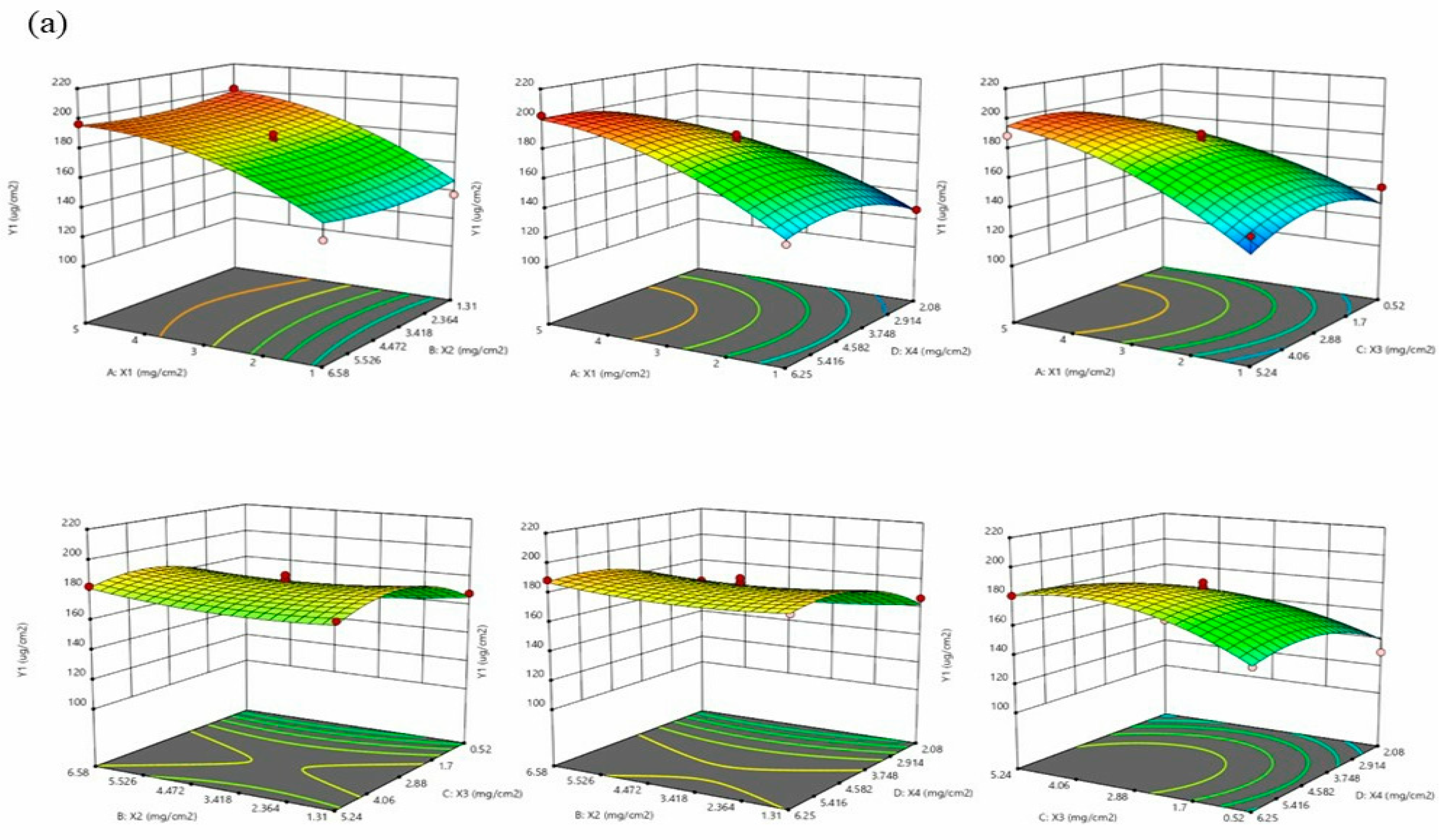
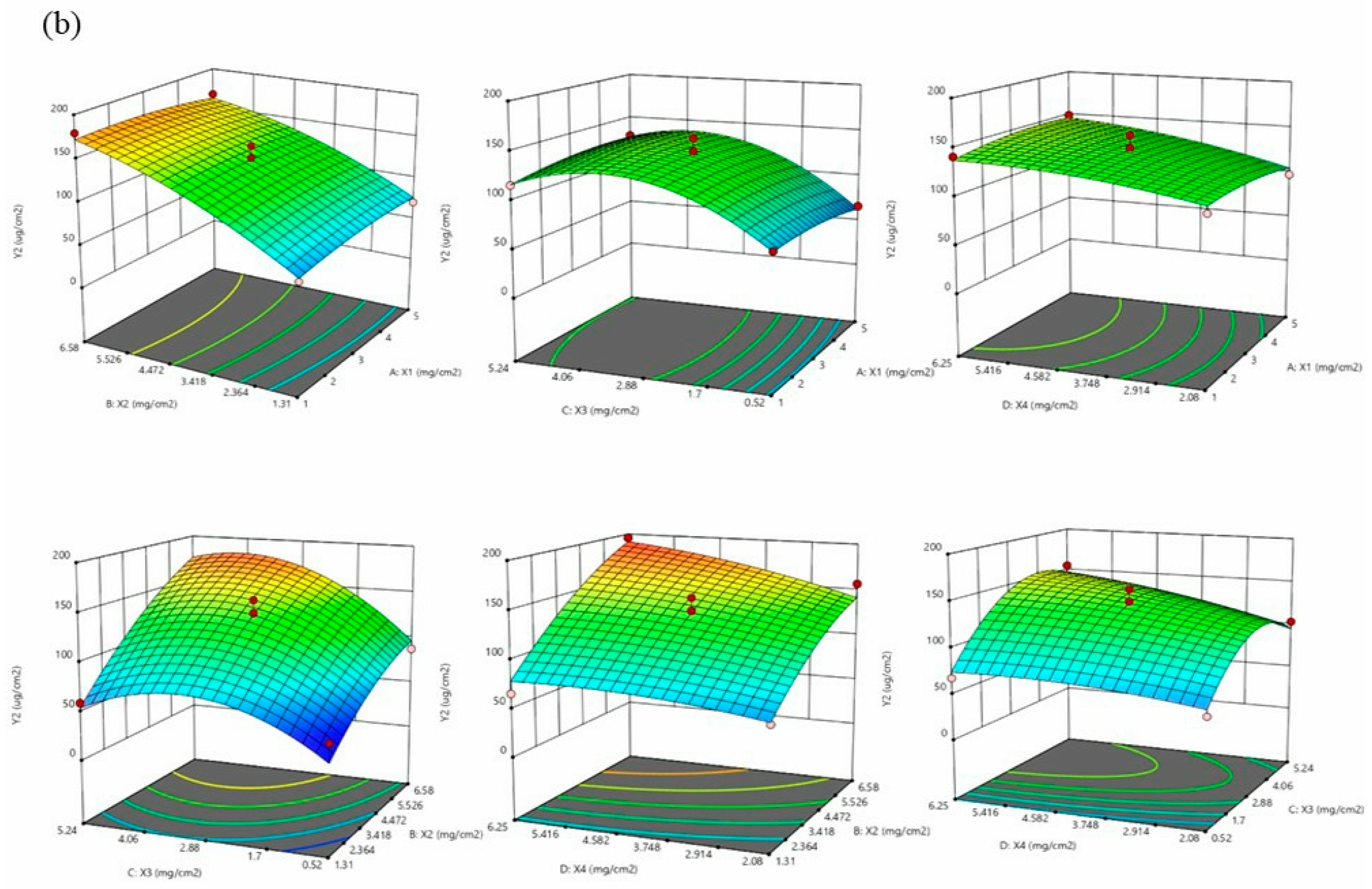


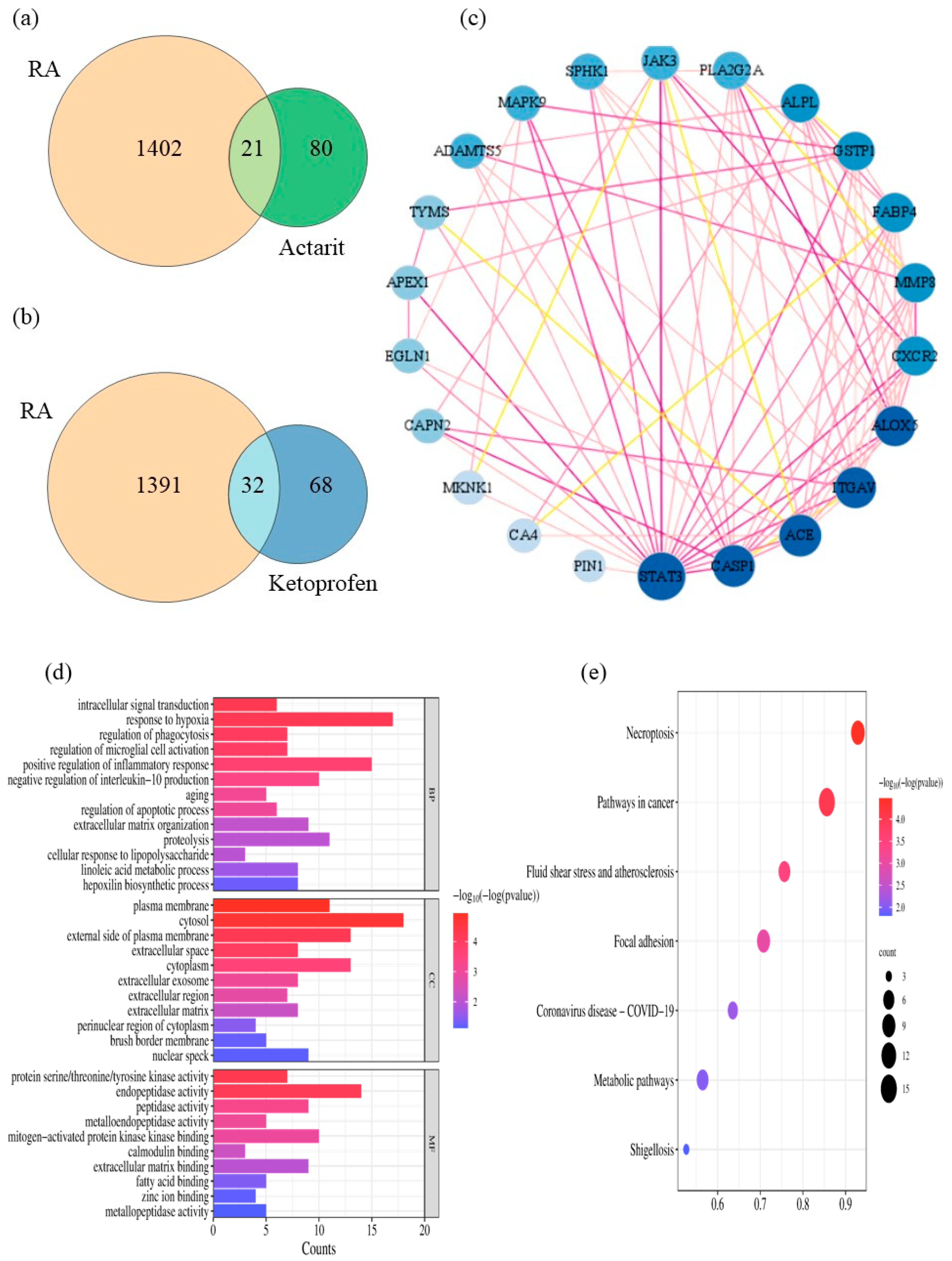

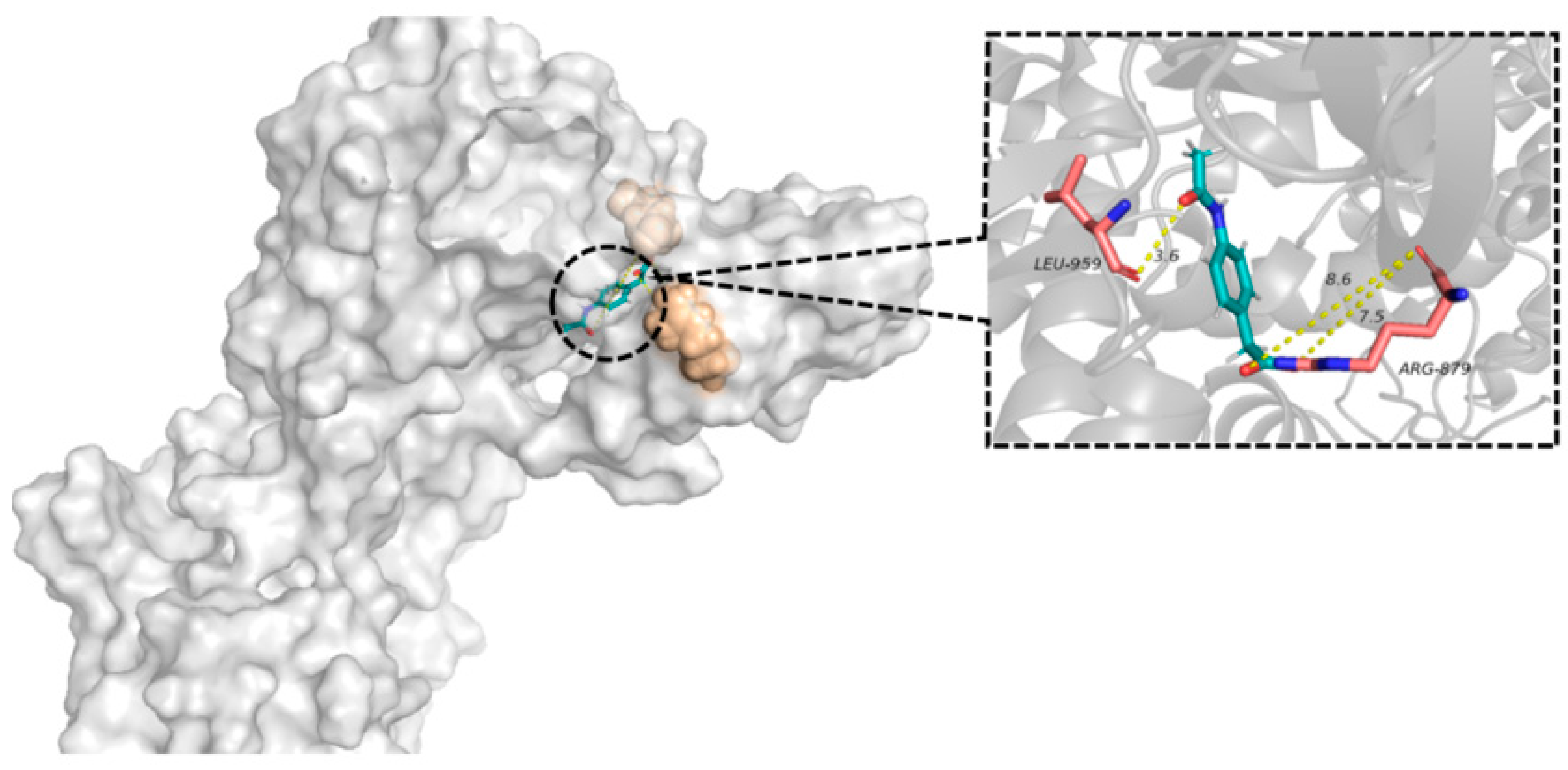

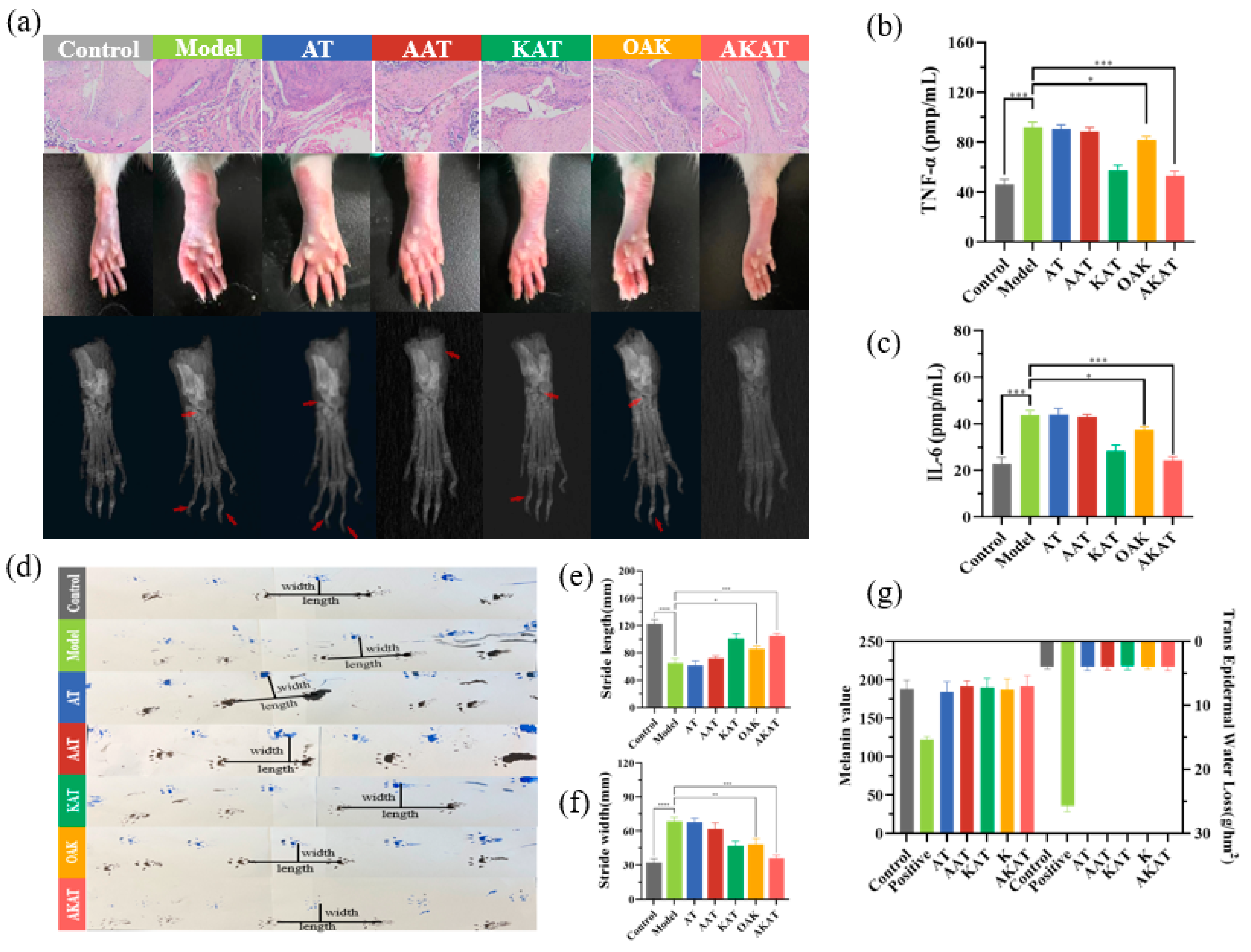
| Counterions | Methanolamine | Diethanolamine | Triethanolamine | Triethylamine | No |
|---|---|---|---|---|---|
| Drug loading (mg/cm2) | 1.00 | 1.00 | 1.00 | 5.00 | 0.44 |
| PSA | DT 4098 | DT 2852 | DT 2287 |
|---|---|---|---|
| Drug loading of actarit (mg/cm2) | 5.00 | 5.00 | 1.00 |
| Drug loading of ketoprofen (mg/cm2) | 6.58 | 6.58 | 2.63 |
| Level | Actarit Content (X1, mg/cm2) | Ketoprofen Content (X2, mg/cm2) | Triethylamine Content (X3, mg/cm2) | Azone Content (X4, mg/cm2) |
|---|---|---|---|---|
| +1 | 1.00 | 1.31 | 0.52 | 2.08 |
| 0 | 3 | 3.94 | 2.88 | 4.16 |
| −1 | 5.00 | 6.58 | 5.24 | 6.25 |
| Run | X1 | X2 | X3 | X4 | Y1 | Y2 |
|---|---|---|---|---|---|---|
| 1 | 0 | 0 | 0 | 0 | 181.64 | 124.94 |
| 2 | 0 | −1 | +1 | 0 | 177.48 | 58.97 |
| 3 | 0 | +1 | −1 | 0 | 160.18 | 87.14 |
| 4 | 0 | 0 | 0 | 0 | 182.65 | 152.01 |
| 5 | −1 | +1 | 0 | 0 | 140.31 | 179.42 |
| 6 | −1 | 0 | −1 | 0 | 142.79 | 73.43 |
| 7 | +1 | 0 | +1 | 0 | 188.74 | 128.94 |
| 8 | 0 | 0 | 0 | −1 | 130.19 | 52.15 |
| 9 | −1 | 0 | 0 | +1 | 138.17 | 140.98 |
| 10 | 0 | +1 | −1 | −1 | 164.45 | 156.47 |
| 11 | 0 | 0 | −1 | +1 | 152.68 | 67.54 |
| 12 | 0 | −1 | +1 | 0 | 168.18 | 44.68 |
| 13 | −1 | 0 | +1 | 0 | 142.64 | 115.77 |
| 14 | 0 | 0 | 0 | -1 | 136.21 | 103.15 |
| 15 | 0 | 0 | 0 | 0 | 175.18 | 138.23 |
| 16 | +1 | 0 | 0 | −1 | 170.89 | 97.15 |
| 17 | 0 | 0 | 0 | 0 | 177.65 | 138.54 |
| 18 | 0 | −1 | 0 | −1 | 166.64 | 59.87 |
| 19 | 0 | +1 | 0 | +1 | 188.62 | 195.64 |
| 20 | +1 | −1 | 0 | 0 | 201.25 | 70.53 |
| 21 | 0 | 0 | 0 | 0 | 185.64 | 127.13 |
| 22 | 0 | −1 | 0 | +1 | 183.12 | 65.63 |
| 23 | −1 | 0 | 0 | −1 | 127.19 | 105.48 |
| 24 | +1 | +1 | 0 | 0 | 196.56 | 167.89 |
| 25 | 0 | +1 | +1 | 0 | 182.65 | 152.01 |
| 26 | −1 | −1 | 0 | 0 | 137.59 | 62.48 |
| 27 | 0 | 0 | +1 | +1 | 180.94 | 155.14 |
| 28 | +1 | 0 | −1 | 0 | 157.79 | 65.74 |
| 29 | +1 | 0 | 0 | +1 | 202.49 | 149.14 |
| Target | Betweenness Centrality | Closeness Centrality | Degree |
|---|---|---|---|
| STAT3 | 150.09 | 0.95 | 20 |
| ACE | 37.33 | 0.72 | 13 |
| CASP1 | 22.21 | 0.72 | 13 |
| ITGAV | 15.51 | 0.70 | 12 |
| ALOX5 | 7.91 | 0.68 | 11 |
| FABP4 | 11.54 | 0.66 | 10 |
| MMP8 | 5.19 | 0.07 | 10 |
Disclaimer/Publisher’s Note: The statements, opinions and data contained in all publications are solely those of the individual author(s) and contributor(s) and not of MDPI and/or the editor(s). MDPI and/or the editor(s) disclaim responsibility for any injury to people or property resulting from any ideas, methods, instructions or products referred to in the content. |
© 2024 by the authors. Licensee MDPI, Basel, Switzerland. This article is an open access article distributed under the terms and conditions of the Creative Commons Attribution (CC BY) license (https://creativecommons.org/licenses/by/4.0/).
Share and Cite
Zhang, F.; Li, L.; Zhang, X.; Yang, H.; Fan, Y.; Zhang, J.; Fang, T.; Liu, Y.; Nie, Z.; Wang, D. Ionic Liquid Transdermal Patches of Two Active Ingredients Based on Semi-Ionic Hydrogen Bonding for Rheumatoid Arthritis Treatment. Pharmaceutics 2024, 16, 480. https://doi.org/10.3390/pharmaceutics16040480
Zhang F, Li L, Zhang X, Yang H, Fan Y, Zhang J, Fang T, Liu Y, Nie Z, Wang D. Ionic Liquid Transdermal Patches of Two Active Ingredients Based on Semi-Ionic Hydrogen Bonding for Rheumatoid Arthritis Treatment. Pharmaceutics. 2024; 16(4):480. https://doi.org/10.3390/pharmaceutics16040480
Chicago/Turabian StyleZhang, Faxing, Lu Li, Xinyuan Zhang, Hongyu Yang, Yingzhen Fan, Jian Zhang, Ting Fang, Yaming Liu, Zhihao Nie, and Dongkai Wang. 2024. "Ionic Liquid Transdermal Patches of Two Active Ingredients Based on Semi-Ionic Hydrogen Bonding for Rheumatoid Arthritis Treatment" Pharmaceutics 16, no. 4: 480. https://doi.org/10.3390/pharmaceutics16040480
APA StyleZhang, F., Li, L., Zhang, X., Yang, H., Fan, Y., Zhang, J., Fang, T., Liu, Y., Nie, Z., & Wang, D. (2024). Ionic Liquid Transdermal Patches of Two Active Ingredients Based on Semi-Ionic Hydrogen Bonding for Rheumatoid Arthritis Treatment. Pharmaceutics, 16(4), 480. https://doi.org/10.3390/pharmaceutics16040480







